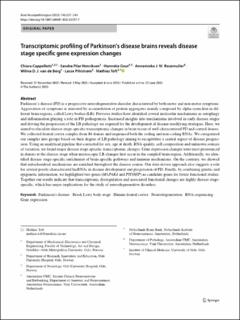| dc.contributor.author | Cappelletti, Chiara | |
| dc.contributor.author | Henriksen, Sandra Pilar | |
| dc.contributor.author | Geut, Hanneke | |
| dc.contributor.author | Rozemuller, Annemieke J. M. | |
| dc.contributor.author | van de Berg, Wilma D. J. | |
| dc.contributor.author | Pihlstrøm, Lasse | |
| dc.contributor.author | Toft, Mathias | |
| dc.date.accessioned | 2023-11-02T07:12:01Z | |
| dc.date.available | 2023-11-02T07:12:01Z | |
| dc.date.created | 2023-07-10T12:20:52Z | |
| dc.date.issued | 2023 | |
| dc.identifier.citation | Acta Neuropathologica. 2023, 146 227-244. | en_US |
| dc.identifier.issn | 0001-6322 | |
| dc.identifier.uri | https://hdl.handle.net/11250/3100146 | |
| dc.description.abstract | Parkinson´s disease (PD) is a progressive neurodegenerative disorder characterized by both motor and non-motor symptoms. Aggravation of symptoms is mirrored by accumulation of protein aggregates mainly composed by alpha-synuclein in different brain regions, called Lewy bodies (LB). Previous studies have identifed several molecular mechanisms as autophagy and infammation playing a role in PD pathogenesis. Increased insights into mechanisms involved in early disease stages and driving the progression of the LB pathology are required for the development of disease-modifying strategies. Here, we aimed to elucidate disease stage-specifc transcriptomic changes in brain tissue of well-characterized PD and control donors. We collected frontal cortex samples from 84 donors and sequenced both the coding and non-coding RNAs. We categorized our samples into groups based on their degree of LB pathology aiming to recapitulate a central aspect of disease progression. Using an analytical pipeline that corrected for sex, age at death, RNA quality, cell composition and unknown sources of variation, we found major disease stage-specifc transcriptomic changes. Gene expression changes were most pronounced in donors at the disease stage when microscopic LB changes frst occur in the sampled brain region. Additionally, we identifed disease stage-specifc enrichment of brain specifc pathways and immune mechanisms. On the contrary, we showed that mitochondrial mechanisms are enriched throughout the disease course. Our data-driven approach also suggests a role for several poorly characterized lncRNAs in disease development and progression of PD. Finally, by combining genetic and epigenetic information, we highlighted two genes (MAP4K4 and PHYHIP) as candidate genes for future functional studies. Together our results indicate that transcriptomic dysregulation and associated functional changes are highly disease stagespecifc, which has major implications for the study of neurodegenerative disorders. | en_US |
| dc.language.iso | eng | en_US |
| dc.rights | Navngivelse 4.0 Internasjonal | * |
| dc.rights.uri | http://creativecommons.org/licenses/by/4.0/deed.no | * |
| dc.title | Transcriptomic profiling of Parkinson's disease brains reveals disease stage specific gene expression changes | en_US |
| dc.type | Peer reviewed | en_US |
| dc.type | Journal article | en_US |
| dc.description.version | publishedVersion | en_US |
| cristin.ispublished | true | |
| cristin.fulltext | original | |
| cristin.qualitycode | 2 | |
| dc.identifier.doi | 10.1007/s00401-023-02597-7 | |
| dc.identifier.cristin | 2161661 | |
| dc.source.journal | Acta Neuropathologica | en_US |
| dc.source.volume | 146 | en_US |
| dc.source.pagenumber | 227-244 | en_US |

